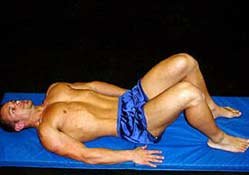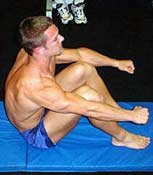Originariamente Scritto da mascotte
Visualizza Messaggio
a me piace e parecchio...
Tired of crunches? Good. The Janda sit-up gets its name from its inventor Czech physician Vladimir Janda, one of the world's leading experts on muscle function analysis and back trouble.
Professor Janda devised a way to completely eliminate the hip flexors from the sit-up, thereby putting the full stress on the rectus abdominus. I am normally opposed to the idea of "muscle isolation" because it negatively affects the body's ability to function as a unit. The Janda sit-up is an exception. This deceptively simple looking exercise is one of the most difficult and effective you can do for your abs.
Exercise Description:
The best way to do the Janda sit-up requires a partner. Lie on the floor with the knees bent to ninety degrees and your feet flat. Your partner will hold on to your legs about halfway between your ankles and knees and apply steady pressure as if trying to pull your feet off the floor. Don't let him.
Tighten your glutes and hamstrings to keep your soles flat on the floor. Keep your arms at your sides and slowly sit up without jerking. Squeezing the hamstrings and glutes takes the hip flexors out of the movement due to a neurological phenomenon called Reciprocal Inhibition, which causes a muscles to relax when its antagonist contracts.
In this case, the antagonist muscle groups are the hip flexors (illio-psoas) and the glutes and hamstrings. It is very important to maintain tension throughout the entire rep. Not only will this completely isolate the abdominals, but by removing the hip flexors lower back stress is virtually eliminated.
You probably won't be able to complete even one full-range rep at first, it is that difficult. If this is the case, begin in the top position and perform a slow negative. Completely relax at the bottom and use your arms to get back into the top position for the next rep. eventually you will build up to full range reps.
Important Tips:
- Keep tension on the glutes and hamstrings throughout the entire movement.
- Roll up and back down, one vertebra at a time.
- Keep the reps in the three to five range.
- If full-range reps are too difficult, begin with negative half-reps.





 si cmq, un po li sento anke io, ma la ventesima parte di quelli alti!!
si cmq, un po li sento anke io, ma la ventesima parte di quelli alti!!


Commenta